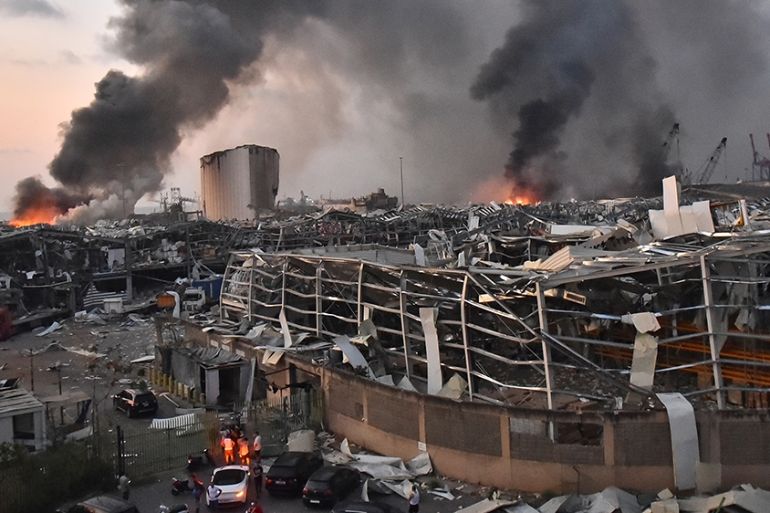Lebanon: What we know about deadly Beirut explosion, in 500 words
PM Hassan Diab says 2,750 tonnes of ammonium nitrate stored in warehouse by port had blown up, sparking ‘a disaster’.

The mega-blast that tore through Lebanon’s capital with the force of an earthquake, killing more than 100 people and injuring more than 4,000 others, resulted from the ignition of a huge depot of ammonium nitrate at Beirut’s port, officials say, but many questions remain.
Here is what we know so far.
Keep reading
list of 4 itemsParallel seasons: How Lebanon hides from reality
Lebanon’s FIBA World Cup journey is about much more than basketball
Justice for the Beirut blast can help avert Lebanon’s collapse
What happened?
A colossal explosion in the port area of Beirut took place at about 6pm local time (15:00 GMT) on Tuesday. It is believed there was a fire leading up to the explosion that flattened the harbour front and surrounding buildings.
Seismologists measured the event, which blew out windows at the city’s international airport nine kilometres (more than five miles) away, as the equivalent of a magnitude 3.3 earthquake.
Video stills show an intense blazing fireball rising above a line of massive storage silos, then a billowing cloud towering into the sky as a powerful shockwave rips through Lebanon’s biggest city.
Why such a big blast?
|
|
Lebanon’s Prime Minister Hassan Diab said 2,750 tonnes of ammonium nitrate, an agricultural fertiliser, stored in a portside warehouse had blown up, sparking “a disaster in every sense of the word”.
Ammonium nitrate is an odourless crystalline substance that has been the cause of numerous industrial explosions over the years.
When combined with fuel oils, it creates a potent explosive widely used in the construction industry, but also by armed groups such as the Taliban for improvised explosive devices.
Lebanon’s General Security chief Abbas Ibrahim said the material had been confiscated years earlier and stored in the warehouse, located close to Beirut’s shopping and nightlife districts.
Was it deliberate?
There has been no indication from Lebanese officials that the explosions were caused deliberately.
United States President Donald Trump said late on Tuesday that US generals had told him the explosions appeared to have been caused by a “bomb of some kind”. “It looks like a terrible attack,” Trump said.
But a Pentagon spokesman, when asked about the president’s remarks, told the AFP news agency that “we don’t have anything for you” and “you will have to reach out to the White House for clarification”.
Diab’s government described the circumstances at the port that led to the explosion as “unacceptable” and promised to investigate.
How many casualties?
The explosion killed more than 100 people and injured more than 4,000, the Lebanese Red Cross said on Wednesday in the latest updated toll.
Search and rescue teams were still sifting through areas surrounding the port, it added, with rubble from flattened buildings spread across a wide area.
Injuries were recorded right across the city, with glass blown out of buildings in multiple districts.
What happens next?
Lebanon’s national defence council has declared Beirut a disaster zone and Diab has appealed to Lebanon’s allies to “stand by” the country and send aid.
President Michel Aoun has announced he will release 100 billion lira ($66m) of emergency funds.
But the country is in the middle of an enormous economic crisis and its hospitals are already overwhelmed by the coronavirus pandemic.
The US, France, Qatar, Iran and even Lebanon’s arch foe Israel have offered to send aid.